The SnowShoes
Here is the first release in early December 20102 in our beautiful places!
Here I am in the "action" (without rolling valley!)
while I go down the beautiful final slope of Mount Rondinaio after the last snowfall in April 2012 ...
P.S. Video and 'the work of my wife, who always supports me!
... and here Anita coming down after me
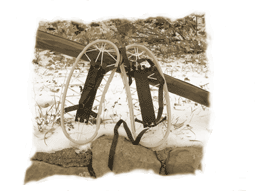 WHAT ARE
WHAT ARE
The "snowshoes" once consisted of a wooden frame with elliptical within a network of ropes of hemp or wicker; using leather straps, were fixed to the boots, their sizes and shapes were variable depending on the location of origin.
Today "snowshoes" there are a variety of shapes, materials and specifications. They are usually chosen according to the needs of use.
Who needs a suitable tool to perform approaches to alpine climbs (waterfalls, canals, high-altitude routes, etc ...) or snowboarding off-piste routes, will definitely need "shoeing techniques" that can also provide a good grip on snow hard and processed, reliable even in steep.
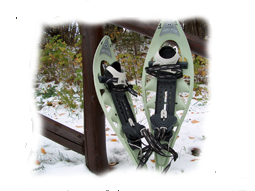 Those who aims to spend a relaxing Sunday in the snow , itineraries basically flat where the objective risks are very small, can safely use a model that offers excellent guarantees primarily to "float " on the snow and no means particularly " insightful . "
Those who aims to spend a relaxing Sunday in the snow , itineraries basically flat where the objective risks are very small, can safely use a model that offers excellent guarantees primarily to "float " on the snow and no means particularly " insightful . "
In other words, snowshoe there are basically two categories: with knives peak (basically similar to the front points of the crampons) and penetrating into wedges below , or lack of these accessories , and supplies only the indispensable ( and racket fixing straps ) .
Another option that characterizes the type of the " snowshoe " is the " slide" the support of the boot : only for models it is possible to have more technicians reversibility .
This is to make "floating heel " (such as in cross-country skiing ) or leave it "fixed" the structure of the " snowshoe ."
Of this particular solution it will be spoken later.
Should be used after an intense snowfall after ascertaining the condition of the snowpack with news from reliable sources and reliable.
Their use has the purpose to facilitate the progression of land covered from fresh snow or transformed, allowing on it flotation.
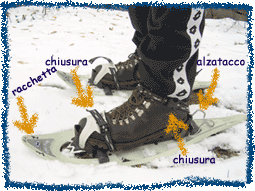
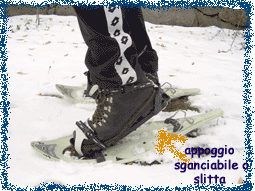
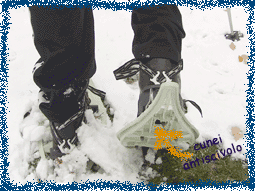
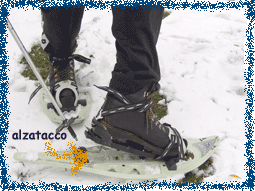
HOW TO USEAfter being fixed to the boots using the special straps of leather or nylon webbing depending on the type , you are ready to go , you'll immediately notice the need to keep a pace with his legs slightly apart , this is to prevent tripping due to the " stepping " racket with the other.
It would be more convenient and functional match you with the use of the classic ski poles (also called improperly rackets ) , preferably telescopic , because having its adjustment possibilities are better suited to your measurements.
Saves energy by offering more and more support in the event of a precarious balance : the control of the balance on the feet, then on " snowshoes " , it is always something very important , especially when learning the technique of use (although minimum ) , you do well to devote a lot of attention . A step well set up from the beginning allows a progression definitely much more economical in terms of energy , very important aspect in mountain activities together with security .
To identify two words " such as walking ," you should have in mind that the limb to move is always to " drain " on the body weight , while maintaining the balance of the one in support.
The so-called "technical measures" ( stride length , for example) are extremely personal parameters : nell'impostarle you will find just the extreme importance of maintaining stability.
In some types of " snowshoes " the support of the boot you can make it articulated so that it becomes possible to make a real step , as if we had nothing at the foot of cumbersome.
In general , however, this option is only used in the most sought after models.
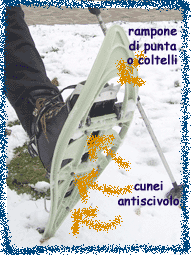 It 's very convenient because it allows a progression that does not require a lot of lifting tool , which is important when driving in snow and without any trace .
It 's very convenient because it allows a progression that does not require a lot of lifting tool , which is important when driving in snow and without any trace .
The weight of the snow load on the racket very tiring legs, but with this system is drained easily when walking , only with a slight twist to the side of the foot.
The racquet instead remains "fixed" has against him the fact that the raising of the foot is weighed down by pounds of snow each time , not always downloaded without specific movements, which inevitably require extra energy that used to take the step .
The choice of the " snowshoe " , is dependent on the use that he wants to do : If you are planning trips along the track and high commitment , you should certainly opt for those models that have the options described here .
With frequent use , and where required by the itinerary is a level of commitment to "good", it will immediately benefit of choice at the time of a possible takeover.
OUR PATHS
Here are some suggested itineraries, all in the vicinity of the Refuge.
Caution
I do not recommend, however, the distance in the event that there was no trace of passage clearly visible to persons who do not practice mountain activities and problems of non-objective fitness.
Who runs the routes traced, even after renting the equipment at our facility and following our "maps", you do so at YOUR OWN RISK.
The Management Ref Victoria does not accept any liability in respect of those who, based on their own free evaluations, decide to go the route suggested by us, even if in possession of the topographic maps we developed and present in reteI OUR PATHS.
Proposals for excursions from the book:
MONTE GIOVO INVERNO,
escursioni con le ciaspole e vie normali di salita alle cime
(Francesco Rosati; Edizioni Il Fiorino, 2010).
The author has come in first person all the routes described in the text. The times are approximate and include the step of a hiker in good physical ideal conditions , snow and weather. Then there may be discrepancies with the times indicated on the previous guides or Charter CAI MO . Remember, however, that in winter the times indicated on this or other hiking maps are to overstate .
That said, the use of this guide book is at your own risk , the author accepts no responsibility legal and lawful for any accidents or damage.
NORTHERN CIRCUS OF MOUNT RONDINAIO
Beautiful hike , the most beautiful among the simple " snowshoeing " described in this guide. It allows to get into the heart of the mountain range , and the environment is mountainous and " real mountains " in the so-called basin of Lake Baccio , surrounded by ridges and gullies Giovo , the pyramid of Rondinaio from the tip of Rondinaio Lombardo. Until Lago Baccio anyone can pick up ( maybe even at night with headlamp ) . Following the route becomes more selective , suitable for experienced hikers , able to orient themselves and be able to assess the reliability of the slopes , so sweet but usually innevatissimi . Suggest a circuit as described in the text.
Recommended Period : from December to April , a few years (recently in 2006 and 2009, for example ), even in early May and still have enough snow conditions . Until Lago Baccio recommended a charming night snowshoeing , maybe the glow of the full moon ( requires headlamp ) .
Slope : NNW compared to Rondinaio and Rondinaio Lombardo , SSE compared to Giovo .
Avalanche risk : risk - avalanches greater than grade 2 would be better not to venture out , avoiding the mouth of the " canyons of the triangle " under the Grotta Rosa.
Other hazards objectives: at the top are steep , with little visibility orientation becomes difficult over the edge of the trees ( there are no visual reference points ! ) .
Sum of slopes uphill about 200 m .
Difficulty EE . For experts, but you do not need any special equipment apart from snowshoes and poles ( if you follow the route described here ) .
Estimated time: 3 hours for the entire circuit .
For a full description see MONTE GIOVO WINTER (F. Rosati ) , Edizioni Il Fiorino ( 2010).
CIRCUS OF THE EASTERN MOUNT RONDINAIO
Excursion of a commitment and not within the reach of all , the most challenging snowshoeing described in this guide. The méta that you will reach is one of the most beautiful and evocative of the Group of Jaufen . Here the winter atmosphere is really great , both for the snow always very generous , particularly forms for both alpine and appealing of the peaks overlooking the circus. In particular , the elegant and photogenic east wall of Rondinaio , one of the most alpine mountains of the entire Northern Apennines , especially when viewed from this side . Curious too Turchino winter , with the lake invisible under the snow, and the little hut often half- buried . The route is suitable for experienced hikers who , if conditions require , also know how to use the proper mountaineering equipment (ice ax and crampons) and properly assess the reliability of the snowy slopes .
Recommended Period : from December to April . In spring, though, you need to leave very early to have reliable and hard snow , given the mainly eastern exposure .
Slope : north -east and east.
Avalanche Warning : If indicated in the bulletins is a risk - avalanches greater than grade 2 (moderate) , do not venture . Especially when crossing the channel at the base of Rondinaio Lombardo can be dangerous.
Other hazards objectives: if the crosspieces and more exposed in the steep ramp access to Lake Turchino are drawn with hard snow and / or ice , snowshoes are inadequate , and must be replaced by crampons. Given the assumptions , you should keep in your backpack on hand , along with the ice ax . Orientation easy , assuming good visibility.
Sum of slopes uphill about 100-175 m, depending on which point in the Eastern Circus , choose to abort the hike.
EEA difficulty with hard snow and / or ice . EE with powdery snow , but even in this case bring in your backpack ice ax and crampons, the land in question is not to be underestimated !
Estimated time about 1.30 hours one way.
For a full description see MONTE GIOVO WINTER (F. Rosati ) , Edizioni Il Fiorino ( 2010).
MONTE Rondinaio (1964 m)
And ' undoubtedly one of the most beautiful and elegant mountains of the Northern Apennines . Perhaps for his appearance reminiscent of the traits of Alpine peaks , is popular with walkers , and, as the Giovo , is perfectly suited to the practice of the various winter activities , offering itineraries to suit all tastes and all levels.
- north side , from the Holy Lake to Lake Baccio and the northern circus .
Superb hiking, perfectly suited to the neophyte of hiking / mountaineering and winter ( cross country skiing as well as the beginner ) . Rises to the top of almost faithfully following the summer trail 523, in an impressive landscape than the average of the Modena Apennines . The problems are minor compared to the ascent to Giovo , and thus within the reach of a greater number of walkers . Nevertheless, caution is needed and some experience. It leads along the gullies of the east wall of Giovo , which often discharge avalanches also the final slope , at the top, can be very insidious , in case of snow. Novice hikers avoid this ascension therefore , and be content with the climb with snowshoes to Lake Baccio , maybe at night ( with headlamp ) .
Recommended Period : from December to April .
Slope : The north.
Avalanche Warning : Be careful when you move to the side of the east wall of Giovo , whose gullies often download avalanches. Instead, the snowy humps that rise along the path is not of particular concern if the avalanche risk is contained up to grade 2 ; prudence when it comes to the line of the ridge , protected from the usual , large frames (albeit less pronounced compared to Giovo ) .
Other hazards objectives : the lack of visibility over the limit of the vegetation , in case of fog . In addition, the danger of underestimating this excursion , far from prohibitive , but even a walk through the daisies.
Sum of slopes uphill 465 meters.
Material: crampons and ice ax , with plenty of powdery snow on snowshoes and poles may be enough , but at least crampons are, however, to keep in your backpack , to avoid unpleasant surprises .
Difficulty: EEA , F- especially in the case of the frozen snow , so the final slope would require a greater understanding of the use of ice ax and crampons .
Estimated time about 2.15 hours .
For a complete description see :
MONTE GIOVO WINTER
(F. Rosati ) , Edizioni Il Fiorino ( 2010).
SOME TIPS
And ' necessary to properly evaluate their knowledge in order to choose the routes suitable to their abilities .
The weather conditions should never be underestimated together with those of the snowpack and time of departure for the excursion , then the travel time of the path itself .
Remember that :
- Be able to give up is a sign of humility and prudence, and can always offer other opportunities for adventure!
- If you are in the group , the more experienced you are also the one who has the responsibility for the choices and the group itself .
And ... now , are you ready to go ?
Recommended Equipment
We provide you with snowshoes and poles , but you should have:
boots or hiking boots (note: the moon -boots do not fit , are too wide and not entering into the snowshoes ), wool socks or modern fibers preferably two pairs , one of which thin to be put in contact with the foot ; warm and comfortable pants , sportswear in general, with the ability to keep a head warm and dry , possibly as shelters from the wind , to be worn in the parks .
The gloves are very important , as is the hat.


